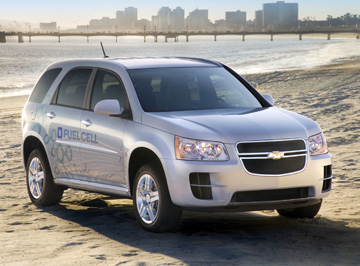
Fuel-cell vehicles have the potential to one day be mass-produced, Larry Burns, General Motors Corp vice president-research and development, tells the National Hydrogen Assn. today at the group’s annual conference in Sacramento, CA.
After spending more than $1 billion in developing hydrogen-powered fuel-cell vehicles, GM has “not discovered anything yet to suggest mass volume cannot ultimately be attained,” Burns says in a prepared speech.
He does not indicate when that might happen but insists, “Mass volume is the only goal that matters from an energy and environmental perspective.”
Meanwhile, he urges the NHA to help accelerate the development of fuel-cell vehicles, stressing hydrogen-based technology promises emissions-free, family-sized vehicles that will be affordable to own and operate.
GM currently has a waiting list of 8,000 people who want to participate in Project Driveway, the world’s largest market test of fuel-cell vehicles.
But the research chief cautions hydrogen fuel-cell vehicles must go through several generations of ever-improving vehicles driven by the public to achieve high sales volumes.
“The true potential of a technology cannot be proven in laboratories or demonstrations,” Burns says. “It can only be proven with real products used by real customers in real markets.”

But to reach the market tipping point, customers must have safe and convenient access to affordable hydrogen.
“What is urgently needed is sufficient investment by energy providers and the cooperation of government to assure auto companies the required hydrogen infrastructure will be in place when we deploy our next-generation of fuel-cell electric vehicles,” Burns says.
GM will locate its fuel-cell test fleet in slect metropolitan areas, so the number of hydrogen stations required will be a modest number, he says.
Only 40 stations along roads from Los Angeles to Santa Barbara, Las Vegas, San Diego and Palm Springs would provide enough hydrogen availability for most LA residents, Burns estimates.
International cities such as Berlin and Shanghai would require about the same number of hydrogen stations, he says.
Burns notes there is enough hydrogen being produced today to fuel nearly 200 million vehicles, and output will grow 45% by 2011. What’s more, there already is a large hydrogen-producing facility in operation near almost every major U.S. and European city today.
Burns says the cost of hydrogen to consumers could be competitive with today’s gasoline prices, as the cost of hydrogen is projected to decrease in the future.
“We truly are at a defining point in the development of (fuel-cell vehicle) technology,” he tells the gathering. “What and how we execute over the next five years will shape the next 50 years.”



